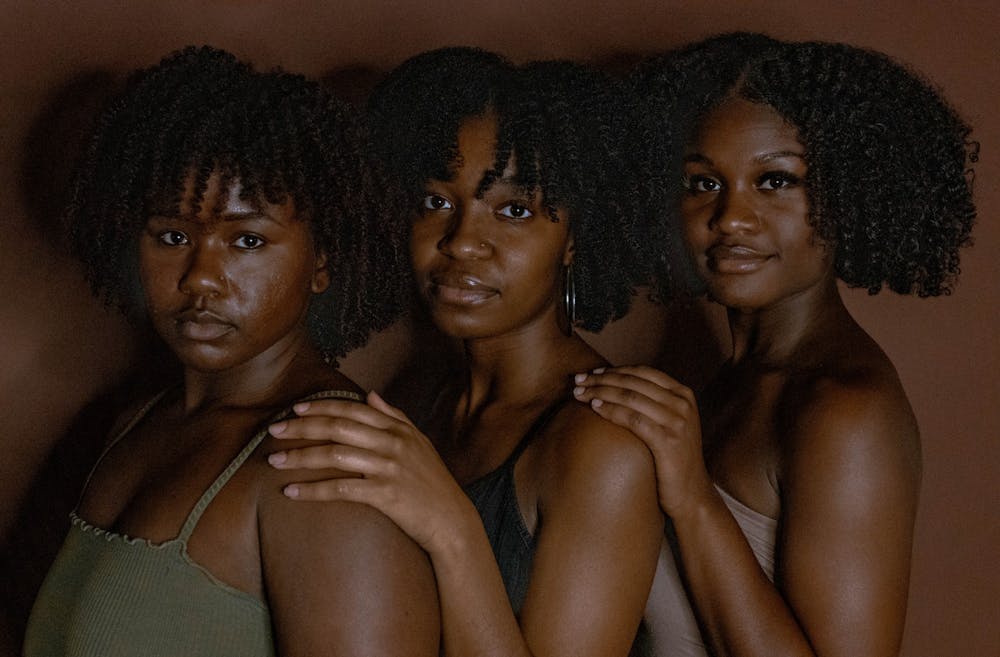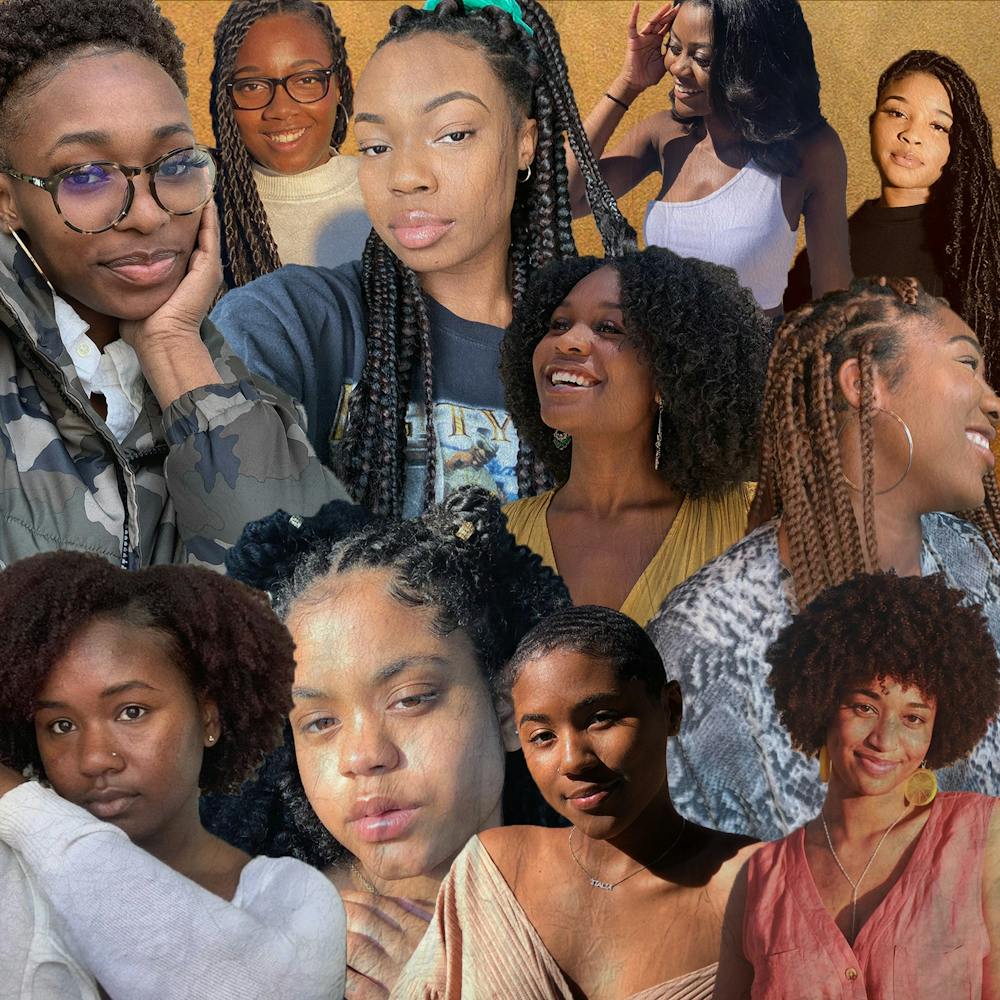Graphic Design by Dejon Johnson
I can recall when I was a little girl, around six years old, sitting in the kitchen of the townhome where my mom and I lived. I sat in a chair by the stove while my mother stood above me with a metal comb sitting on the burner, turning red with heat. I could hear the sizzle of the hair products as the hot comb made contact with my blow-dried bundle of frizz. I can still feel the anxiousness from built-up anticipation of too much heat coming too close to my scalp, resulting in a jump followed by a scolding from my mother. I don’t remember how long the process of hot combing my hair actually took, but as a child, 20 minutes was an hour and one hour was easily three, as time was still a warped, jumbled mess in my developing mind. Nevertheless, I would sit and endure with eagerness because I would finally have long, straight hair. The epitome of beauty.
As this memory fades from the forefront of my mind, there remains a faint image in my head of me walking outside the house proudly with my head held high and my Beyonce-esque locks blowing in the wind behind me. In hindsight, my hair was nowhere near as straight or as long as any pop or R&B stars’ hair that I had seen on TV. And my fantasy was short-lived, as my mother would quickly tame my semi-straight hair with colorful hair bows, twists, and ribbons to remain “age-appropriate.” Regardless of the discrepancies in my memory, I can vividly feel the pride and excitement I felt from the rare occasions I was allowed to get my hair straightened... and actually wear it down in public like all the trendy adults did.

The sad truth is that I hated my natural hair for most of my adolescent years. It was inconvenient, deemed unattractive, too kinky, too big, uncontrollable, untamed, and too bold. When my mom stopped doing my hair and I began taking over in middle school, I started to explore it more. I tried stepping outside the boundaries of pig and ponytails. I tried puffs and afros. I tried picking it out and wearing it wet (this was before I had any knowledge of a wash-n-go), but I still hated it. I begged for a relaxer, for a texturizer, honestly, for anything to flatten the bed of springs that made my head its home. My eyes would well with tears of shame as I would struggle to pull my hair back into a simple ponytail while looking in the mirror feeling inferior and undesirable because of my ungodly coils of hair.
Thinking about this takes me back to every 1st and 3rd Sunday when I would visit my father at his then bachelor pad that always felt like home. I would sit between his legs at the foot of his bed next to a cup of hot water and a hard wooden brush. My dad would begin what felt like the longest and most excruciating process of repeatedly dipping the brush in the cup, brushing my hair into the vice grip of his palm, and finally wrapping a hair tie around it, creating a broccoli-shaped poof right on top of my head until it was perfectly presentable for church. The end results were admirable but the road there felt treacherous to my elementary-aged senses. Every time I begged my parents for straightening chemicals and tools they constantly told me no. My dad loved my coily fro and still does to this day. He continuously lectured me about the beauty of my God-given crowning glory, yet those messages of self-love did not take root until much later in life.
My hair exploration stage did not last very long. By high school, if I was not flat ironing my hair, I was either pulling it back into a ponytail or up into a bun to minimize it, ultimately minimizing myself. I never wanted my natural hair to draw attention, so although I often wore it in its natural state, without heat straightening, I hid it with endless hair ties and bobby pins. I tried to tame it— never let it off the leash. I feared that my hair would make other people uncomfortable. I feared it so much, that when I finally ventured back out and let it loose, I would always shrink myself into my desk so others wouldn’t be distracted by it— similar to how many black women have had to shrink their ideas, opinions, and dreams to keep their non-black counterparts comfortable. Not only did I feel like wearing my natural hair was a distraction, but I also felt like an object of entertainment or amusement. From backhanded comments from my white classmates about “how big and fluffy” my hair was or “how fun” and “festive” it is to being petted and prodded like a zoo animal. Even as I slowly began to tolerate my hair, I still bore the shame of it and the attention it brought, often leading me to rush self-consciously to the bathroom soon after arriving at school to quickly pull it back into the safety and security of a ponytail.

Photos by Zhané Bradley
Now, years later, I am absolutely in love with my hair and all the stares and ogles it brings with it. Don’t get me wrong— sometimes it’s frustrating to deal with and I’m ready to put up a fight with my curls, but there is always a base level of appreciation and admiration. My lengthy hair journey has been riddled with a few chops, lots of box hair dye, a tragic bleaching episode, and, most importantly, a plethora of self-love and growth. When I see my hair now, I get excited at all the opportunities to explore and try new things or stick to old tricks. I can chop it off and watch it grow back or braid it up and wear it long down my back. My hair journey is a reflection of my personal journey as a black woman. I have learned to embrace it just like I had to learn to embrace my blackness. Despite all the hate the world gives my hair, I will proudly flaunt it, just as I will proudly flaunt my mocha skin and all the complexities that come with it. I am black. I am a woman. My hair is often inconvenient, but so is being a black woman in this country. My hair has been deemed unattractive by eurocentric beauty standards, but it sparks the latest trends when a fair-skinned celebrity appropriates it. My hair is kinky and coily. It can’t be traced, tracked, or followed, just like the beautiful brown woman that it adorns. My hair is big, in order to match my heart that allows me to turn ordinary straw into extravagant gold. My ferocious mane is uncontrollable and untamed, like the flames for justice and innovation within. Finally, my hair is bold in whatever state you find it, whether that is a curly fro, a sleek slick-back, a crown of braids, or a silky blowout. My hair is and will always be bold because I wear it. As a black woman in America, my existence and persistence in itself are bold, so it is only right that my hair complements that. I think God knew that when he created us, black women. He knew we’d need a little pizzaz to match the fire inside that equips us to fight a world so ready to douse our flames. When you see my hair you see a reflection of me. Forever changing and never stagnant. My hair is my crown, my hair is my glory, and if I cut it all off today it would remain so because it is me. To accept my hair was to accept myself. Thank God my daddy planted those seeds of self-love in a world filled with hate. It took some time to break through the surface but those roots now run deep and I see the fruits of his and my mother’s labors. The fruits of every black queen before me who dared to scream in defiance with their black girl hair in a white-washed nation. I am not my hair, but my hair is indeed ME.
Photo gallery by Zhané Bradley: https://www.gandbmagazine.com/gallery/0kgl4tq8ljjtiuz
Check out the visual short film that accompanies this piece
Videography by Nancy Sterrett



